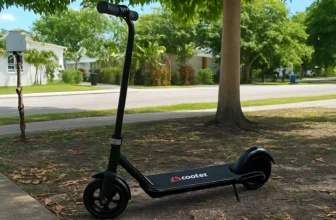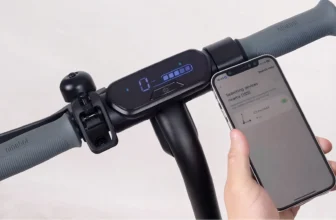As you zip around the city on your electric scooter, with wind blowing in your hair, mindlessly and effortlessly going from one place to the other. Have you ever stopped to think about what keeps you connected to the pavement, what is that thing that’s ensuring you have a safe and pleasant ride, and quite literally, pushing you forward?
That’s right, it’s your electric scooter’s tires.
Often overlooked but absolutely crucial, electric scooter tires are the unsung heroes of your daily commute or daredevil adventure. They’re not just black rubber circles; they’re sophisticated components that can make or break your riding experience.
In this guide, we are going to just as rigorously roll into the world of electric scooter tires. We’ll explore everything from the different types of tires to the science of tread patterns. Whether you’re a seasoned scooter enthusiast or a curious newbie, prepare to gain a whole new appreciation for these round wonders. Because although they may seem simplistic, there is more than what meets the eye when it comes to electric scooter tires.
Why Should You Care About Your Electric Scooter’s Tires?
Well, they’re not just about keeping you rolling. The tire setup can extend your battery life, improve your scooter’s handling, provide a smoother ride, and they are a vital part in keeping you safer on the road. On the flip side, the wrong tires… let’s just say nothing can deflate your enthusiasm faster than a puncture on a busy Monday morning. As a best case scenario.
Or if you’re like me and need the lessons to be hard and swift. Like the time I took one last ride on my electric skateboard while I was waiting for the new set of tires without cracks in them to arrive. Add in a bit of morning dew and I got sent into a curb at 28 mph which resulted in a couple of broken bones in my right foot putting me on the sidelines for 2 months. Not worth it! I consider myself very lucky that I was able to slowly ride home after that crash.
I don’t mind being the warning example to you all, after all it comes with the territory. So let’s not repeat my stupidity and instead let us deep dive into this rubber-meets-the-road journey together and by the end of this guide, you’ll be a veritable tire aficionado, armed with the knowledge to make the best choice for your ride, no matter the terrain or weather.
The Different Types Of Electric Scooter Tires
There are 3 main categories of electric scooter tires and those are pneumatic, solid, and honeycomb tires. They all have their strengths and weaknesses and choosing which one to use isn’t always straightforward. Before you can do that let’s learn a bit more about what sets them apart.
Pneumatic
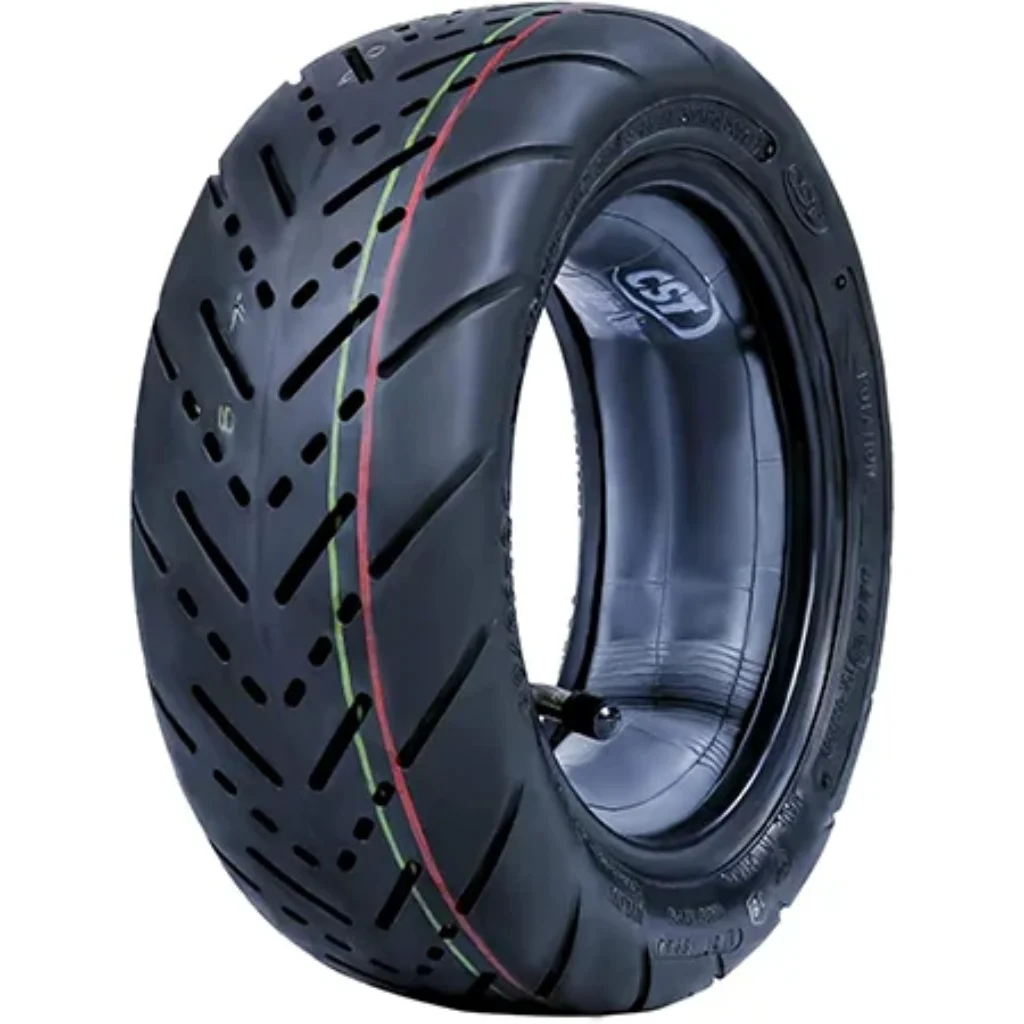
Pneumatic tires are air-inflated tires, they can be either with a tube or without, also known as tubeless tires. Tires that utilize a tube work similar to old bicycle tires where you have an inflatable tube inside the actual tire. Tubeless tires on the other hand are sealed to the tire rim and then inflated. In our tube vs tubeless guide we teach you how to spot the difference and also give you the pros and cons of each type.
Benefits
- Air filled tires provide the most dampening/cushioning to your ride, negating a lot of bumps in the road.
- You can adjust the tire pressure for a greater effect at the cost of speed/range, and increased risk of a flat.
- They provide your ride with the best traction on all surfaces, especially if you’re riding on wet/snowy roads.
- Self-sealing/healing options available for the tubeless tires making them more puncture resistant.
- Lowest noise levels
Drawbacks
- They are prone to flats and they wear out quicker than solid tires.
- Increased frequency of tire maintenance.
Solid

Solid tires are as the name states made out of solid rubber, holding no air it makes them pretty much maintenance free as they hold up very well from wear and tear from regular use. However, they do slip easier as the traction isn’t as good which results in their profile diminishing faster. But even if you lose a chip of rubber it won’t make much of a difference in your everyday ride.
Benefits
- No risk for flats due to there being no air in the tire.
- More durable than your average pneumatic tire.
Drawbacks
- Hard rubber makes your ride bumpy, even on slightly rough roads.
- You get far worse traction, especially on wet surfaces, and you can completely erase any ideas of riding on slightly icy/snowy roads.
- Highest noise levels
Honeycomb
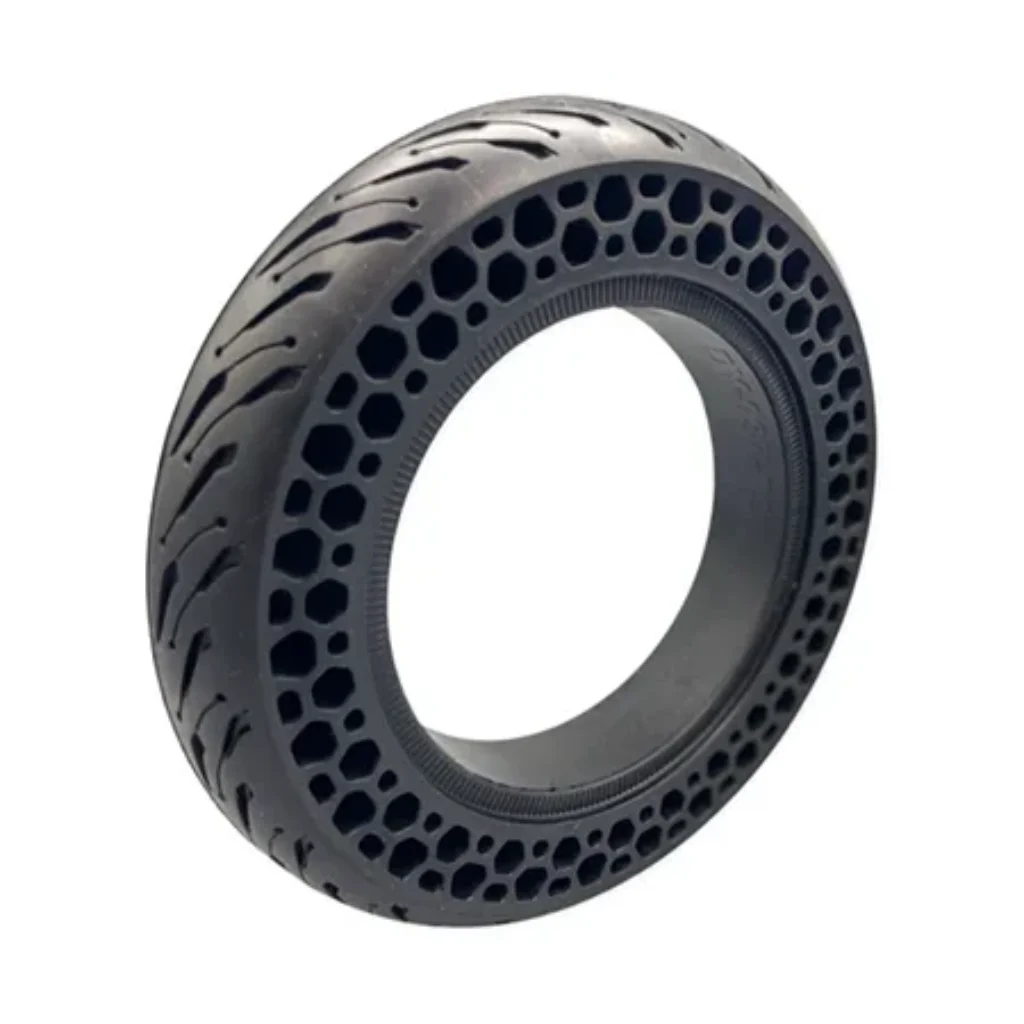
Honeycomb, vented, and foam-filled tires have pockets of air/foam manufactured into them in order to provide you with a slightly smoother ride. In terms of performance they are somewhere in between a solid tire and a pneumatic one.
Benefits
- They are completely flat free.
- Provide some dampening to your ride making it handle slightly uneven roads better.
- Slightly better traction than solid tires
- They are low-maintenance tires.
Drawbacks
- Traction may be better than solid tires, but it’s still not comparable to pneumatic ones.
- They are known to slip when they compress on a bump or due to weight.
- Low to mid noise levels.
General Electric Scooter Tire Characteristics
Materials
Even if all tires are made out of rubber, they can have different softness, inner cords and materials which give varying benefits.
A softer rubber tire has better grip and smoother curve handling at the cost of how often they need to be exchanged, whereas harder rubber tires provide less maintenance and better results on uneven terrain, but don’t give as good a grip during curves.
Tire Size and Dimensions
Electric scooter tires range in size from around 5” for the smaller kids models to 16” for some of the larger more bike-like models. The width generally ranges between 1.5” for the smaller models to 3” for performance models like the Kaabo wolf warrior.
Common sizes
Based on our analysis of over 200+ electric scooter models the most common tire size is 10” x 2.5”. That means 10-inch in diameter with a 2.5-inch width(grip surface). This is the type of tire you find on the most popular consumer models like the Segway Max Series, Xiaomi m365, and well, most other models too. They are large enough to give your ride plenty of benefits in terms of shock absorption and traction, without hampering it by creating too much tire to road friction.
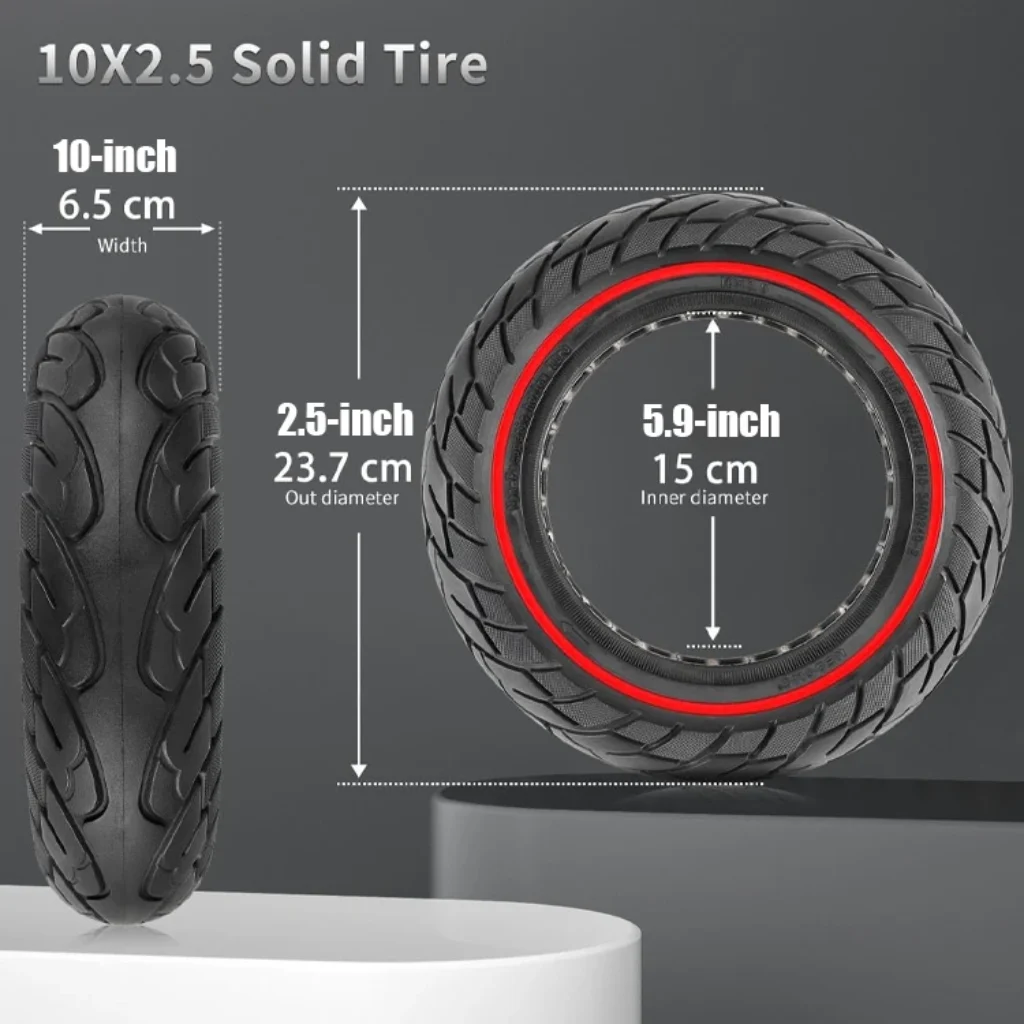
How size affects ride quality and performance
The size of your tires will impact how your electric scooter handles and which size to go for is heavily dependent on where you will be riding and personal preference.
The benefits and drawbacks of the different sizes aren’t set in stone as tire width also has its part to play, but generally this is what you can expect:
10-inch tires and above
8-inch tires and below
Tread Patterns
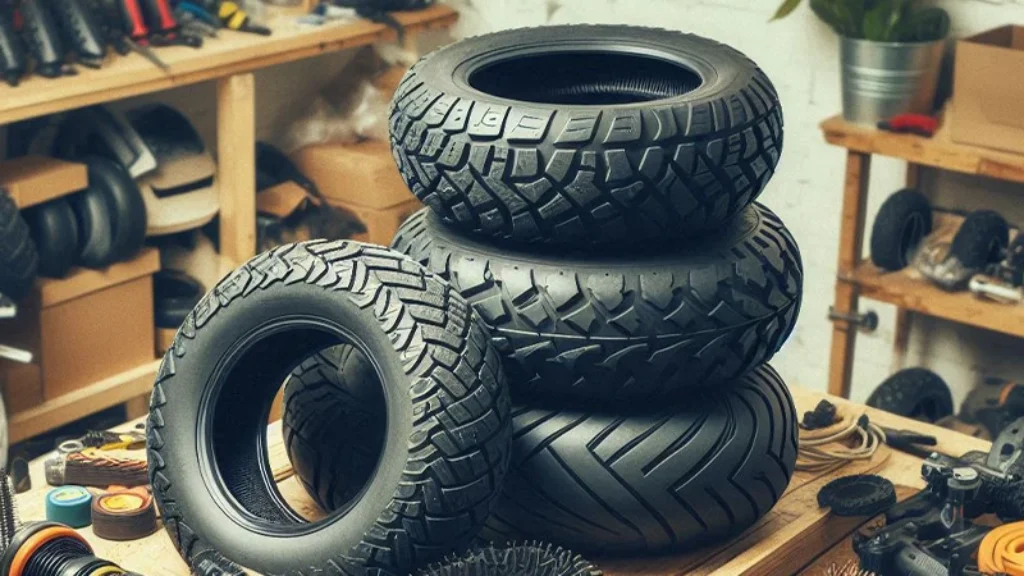
Electric scooter tread patterns are a complex topic, but as a seasoned expert, I recommend most riders opt for an all-round design also known as street tires. Look for a tread with sufficient depth to effectively manage wet surfaces. It’s no coincidence that 10″x2.5″ pneumatic tires have become the de facto industry standard.
These tires strike an optimal balance between performance and versatility. The 10-inch diameter provides stability and shock absorption, while the 2.5-inch width offers a good contact patch for traction without excessive rolling resistance. The pneumatic design further enhances ride comfort and grip.
This combination addresses a wide range of riding conditions, from dry urban pavements to slightly damp roads, making it suitable for most riders’ needs. While specialized treads exist for specific conditions, such as gravel, off-road, or snow/ice. A standard 10″x2.5″ pneumatic tire will serve the majority of electric scooter enthusiasts well.
Different types of tire tread pattern
Just like with cars, there are two main types of tread patterns for electric scooters: Symmetrical and Directional. Symmetrical is the easiest to install as you can literally mount them any direction you like, while directional needs to be correctly installed for maximum traction.
Electric scooter tires for various terrain
Off-road
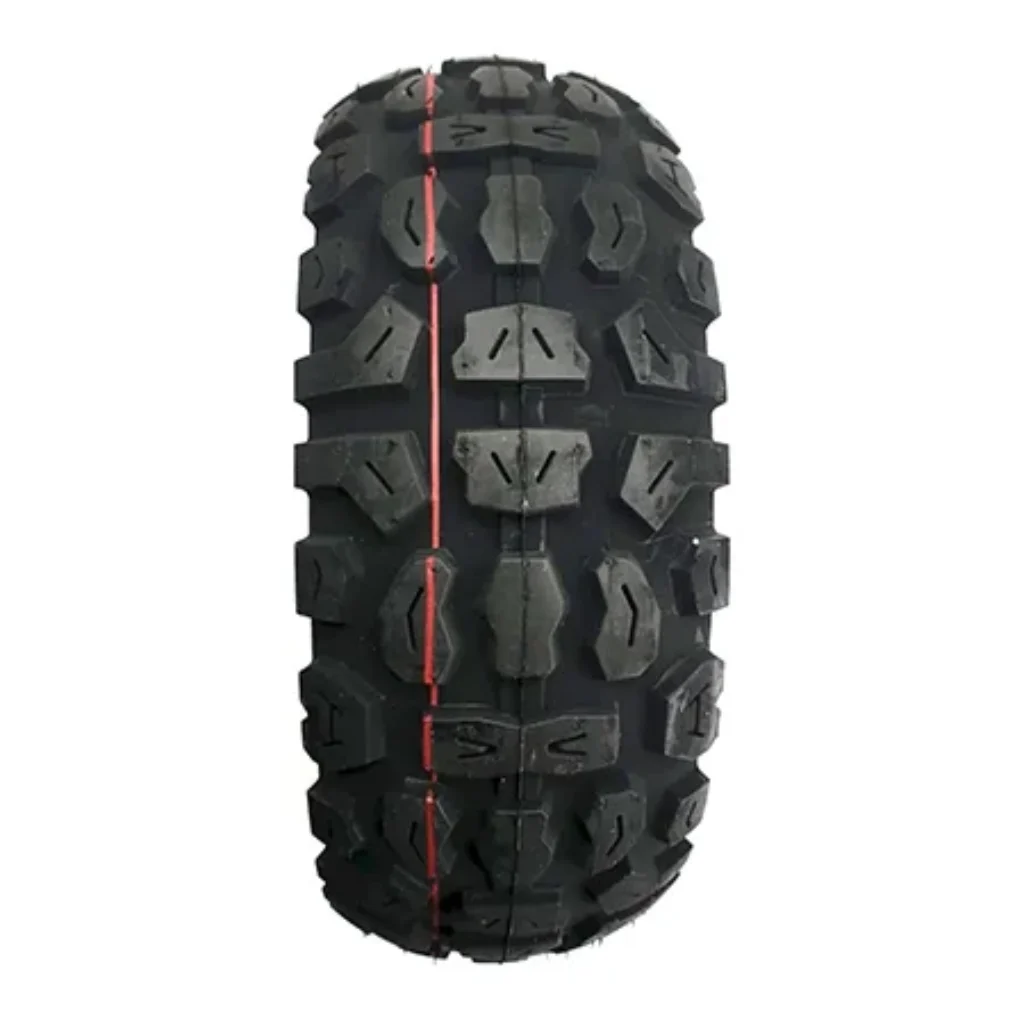
When it comes to going off the beaten path, riding on gravel, dirt, or sand you will need a robust tire built for the task. Off-road tires serve just that purpose, with hard rubber, deep threads, and a wide profile they deliver impeccable grip on rough terrain.
Usage: Dirt, gravel, sand, grass and similar terrain
Racing slicks

If your intention is to ride a high-performance racing scooter and need the best possible grip and curve handling on very smooth surfaces like a race track. Then racing slicks will heighten your adrenaline rush, enabling you to take curves like never before and with a grip like no other. Unless it’s wet, since they are soft and lack any pattern they get really slippery on wet roads.
Usage: Dry smooth surfaces, racing track
Street tires
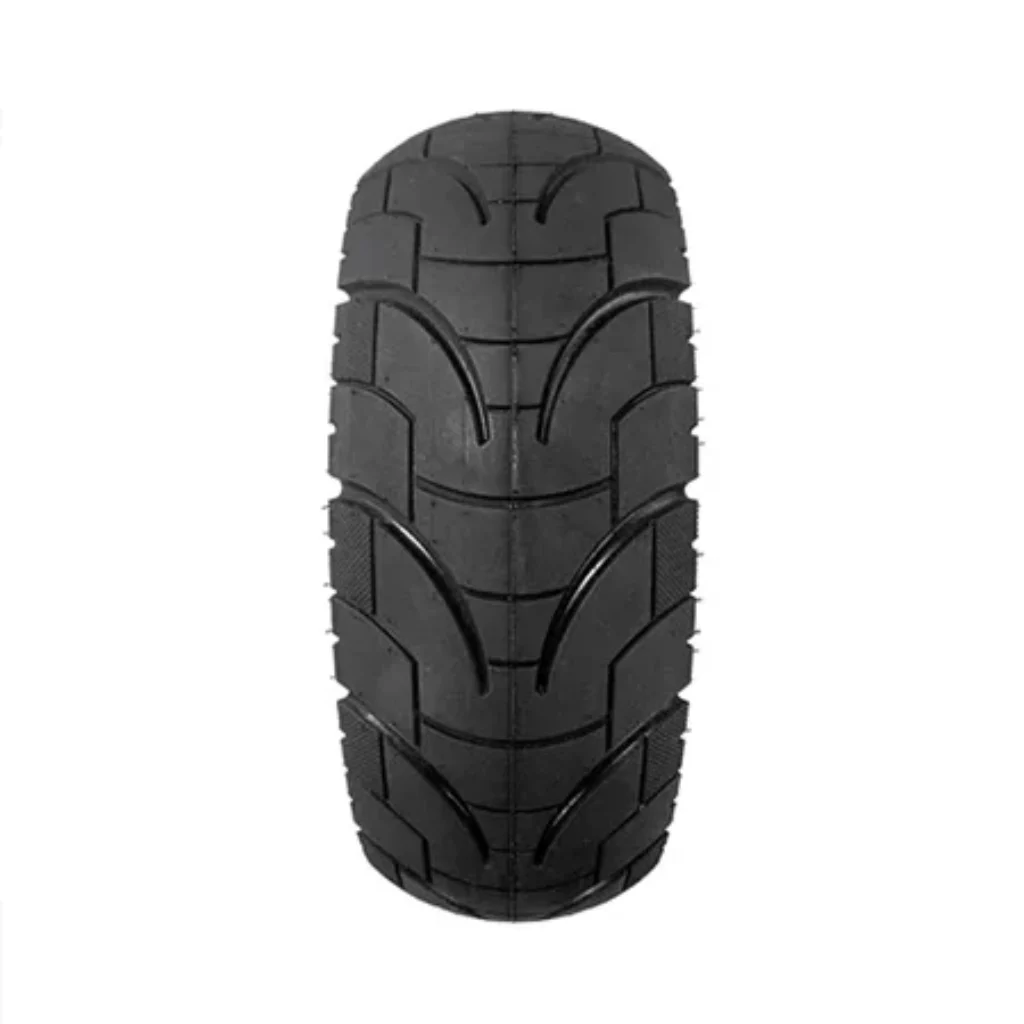
Street tires are the tires you find as standard on 80% of the models out there. They can be either symmetric or directional and work well on most surfaces the regular scooter rider has to tackle on a daily basis. They create little resistance and are optimized for comfort and versatility, why you find them on every single model that ended up on our commuting scooter recommendations.
Usage: Long range, City riding, Commuting, Allround
Hybrid
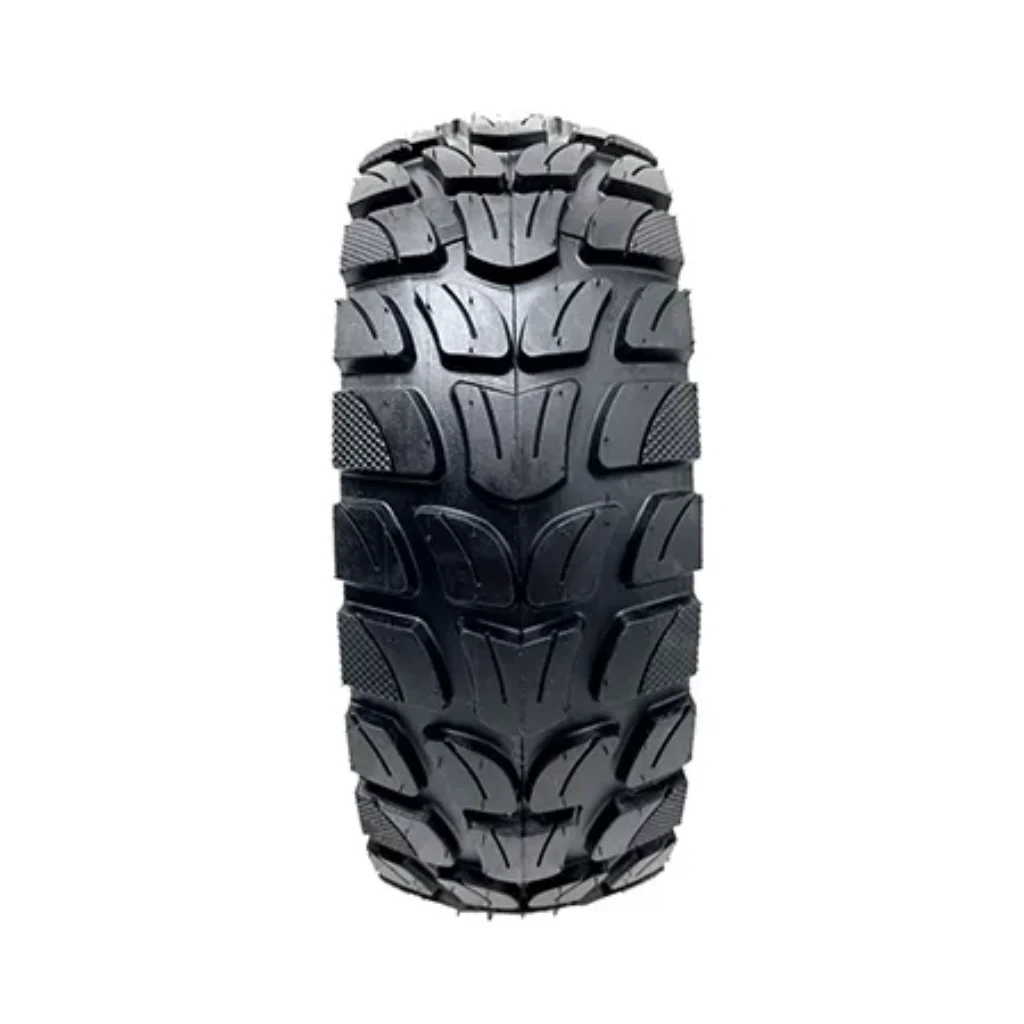
Hybrid tires are built to hold and to be able to tackle a vast range of different terrain and weather conditions. They work just as well on smooth asphalt roads, as they do on that shortcut through the woods. A great choice for those of us who want to keep our options for routes open.
Usage: Allround, Tackling diverse terrain on a daily basis
Studded/Snow
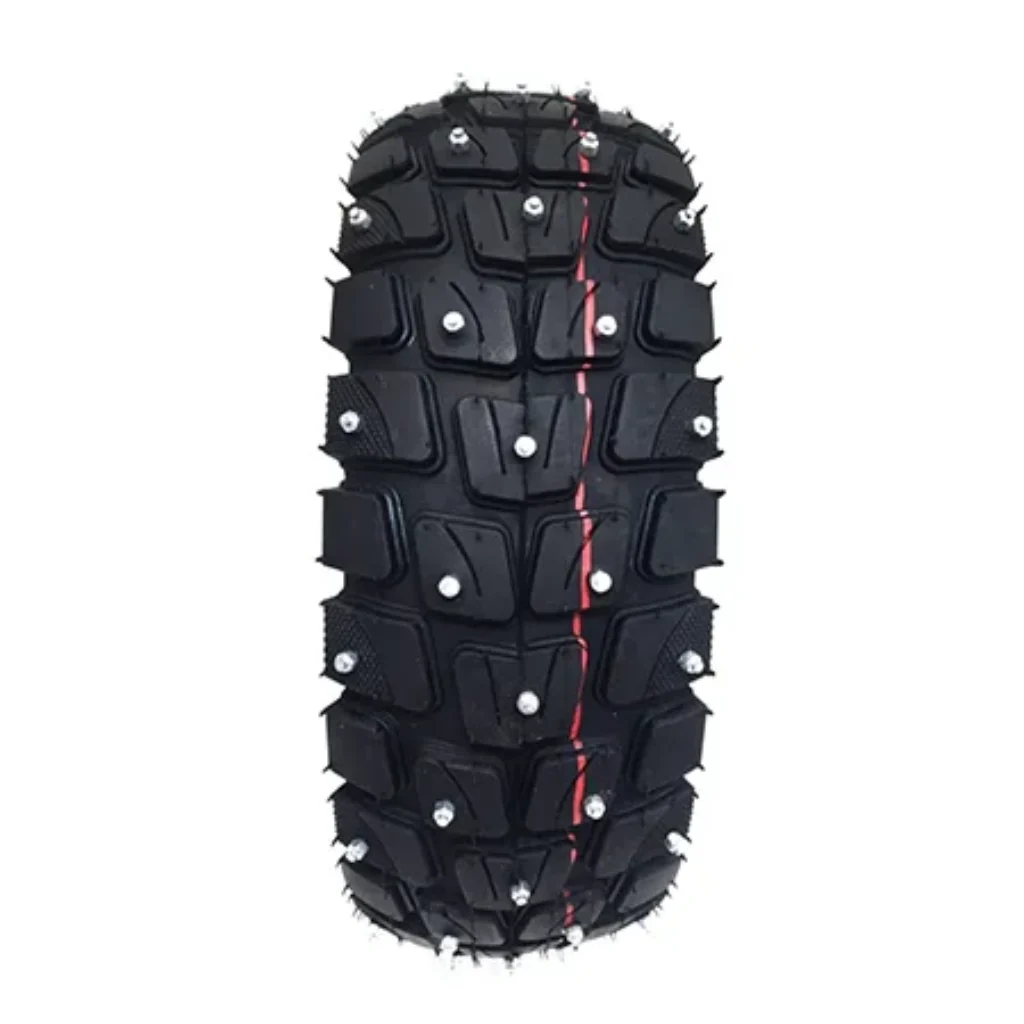
You guessed it right, studded electric scooter tires have metal studs on them in order to give you better grip during the winter season. Perfect for those of us less fortunate souls who don’t get to live in a place where snow is only something you see in the Christmas movies.
Usage: Winter riding, Ice, Snow
Maintenance and Care
For your safety it’s not only important to have the right set of tires that are purpose built to handle the terrain in which you ride. You also need to take good care of your tires by doing proper maintenance. This can dramatically increase your tires lifespan, performance, and the range/speed of your electric scooter.
Pneumatic
Regular check ups list
- Check the tire pressure on a regular basis.
- Clean and remove any dirt.
- Check the thread pattern on a monthly basis.
- Keep a lookout for cracks in the rubber.
Proper inflation for pneumatic tires
The general rule is that the psi on the average pneumatic tire on an electric scooter should be somewhere between 40 and 60 psi. You can either pick a good middle ground of 42-45 psi. Or you can slightly alter it up or down depending on your personal preference for a smoother ride or better performance.
A higher tire pressure gives your scooter less rolling resistance which results in better range and top speed, but it heightens the risk for flats, makes your ride less smooth, and lowers the tire connection surface to the road.
A lower tire pressure provides a smoother ride, better traction, and better braking. But it gives you more rolling resistance resulting in lower speed and range performance, and makes sudden blowouts a possibility due to increased heat creation in the sidewalls of the rubber tires.
Learn to keep your tires in mint condition and how you can adjust your tire’s pressure for a better and safer ride by read our tire pressure guide.
Make your tires flat resistant
Today a lot of tubeless pneumatic tires come with self-sealing coating or gel inside them. But not all. Even if your scooter doesn’t come with it out of the box I highly recommend that you order a tube of self-sealing slime and add it yourself. This adds an extra layer of security against future flats.
It is cheap, the process is straightforward, and it can save you a lot of headache. There are no good reasons not to take the proactive approach.
Solid/Honeycomb
Solid, vented/honeycomb tires are much more maintenance free. Not only are they more durable due to their harder rubber compound, but you also eliminate the risk of flats completely.
However, keeping a close eye on your tires is still no less important.
Regular check ups list
- Keep them clean from dirt and mud.
- Inspect for rubber chips and cracks.
- Keep an eye on the thread pattern to avoid riding with slicks as they wear down.
When to Replace Your Electric Scooters Tires
The average lifespan of electric scooters tires are up to 1500 miles for pneumatic tires, and up to 2500 miles for solid tires, while honeycomb/vented tires have a slightly shorter range at 2000 miles.
The life expectancy of your tires are highly dependent on regular maintenance, rubber compound, temperature exposure, riding style, and terrain. The better care you take of your tires the longer you can expect them to last.
Here are a list of signs that your electric scooter tires are ready to be replaced:
Pneumatic
- Worn out thread pattern
- Visible cords
- Cracks in the tires sidewalls
- Deflating
- Blow-outs
- Any other visible damage
A general rule of thumb is that if nothing of the above happens before 2-3 years have passed, you should consider changing your tires anyway. Even if your electric scooter’s tires look good from the outside, they can dry up and have hidden cracks created over time. Note that I have models on which I’ve ridden thousands of miles in snow and heat over a span of 4-5+ years and they still have the original rubber tires on them. So you can get away with it for twice the amount of time, but as a professional I can’t really recommend taking that unnecessary risk for something that costs a few bucks to have replaced.
Solid/Honeycomb
- Cracks
- Dried up rubber
- Chips of rubber missing
- Worn down pattern depth
Solid and honeycomb tires have a much longer life expectancy than pneumatic tires. I have models from 8+ years ago that still have good running tires on them and they’ve gone through some extensive heavy-duty riding. But my recommendation is to change them every 4-5 years just so that the rubber doesn’t get dried up and cracks in the middle. If that would happen mid-ride then you are in for a much more costly incident, both for your scooter and yourself.
Performance Considerations
Impact On Range and Battery Life
Bad tires, whether it is from using the wrong tires for the type of terrain you’re riding on, a low air pressure, or worn out tires that don’t provide efficient grip. It can dramatically impact the range capabilities and the longevity of your battery.
Below is a graph that showcases how tire air pressure impacts the range you can go on the most popular scooter, the Segway Max G2. We found these results during our research phase when we were trying to find the best ways on how you can maximize your electric scooters range.
Effects On Speed and Acceleration
The right tires for the task can easily make your scooter run smoother and faster if maintained correctly. It all depends on where you ride.
Off-road tires may give you the best speed, acceleration, and performance on rough terrain, but in the city the large patterned tires will slow you down in comparison to street tires.
Worn down tires will slip easily, lowering both acceleration and the safety of your ride.
Handling and Stability
As your tires wear out you will notice the handling of the scooter will become different. Old worn down tires will give you less traction resulting in longer brake distance, worse cornering, and even slipping while turning is a possibility.
Fresh, well maintained tires will make your scooters curve handling smooth and you’ll be able to stop on a dime when you need to.
Comfort and Ride Quality
Your scooter’s tires are what connects you with the road. Riding an electric scooter should be smooth, safe, and fun, and a good set of tires will provide just that. There are many ways your tires increase the comfort and quality of your ride, but the most noticeable ones are by absorbing shocks and bumps from uneven roads and making your scooter run quietly without a ton of noise.
Shock absorption
While you can get away with using solid rubber tires in a well maintained city with smooth roads, if you intend on riding on anything less than pristine roads. You will want to opt for the additional shock absorption from pneumatic tires. If you really want that low-maintenance option, then honeycomb tires, although they’re not as good at reducing shocks as pneumatic tires, they still provide a little bit of the best of both worlds.
Noise levels
If there is anything in this world I dislike more than having a bumpy ride, it is excessive noise. You want to be able to hear that electric motor wizz as you accelerate down the road.
When it comes to electric scooter tires I like to categorize them into 4 different noise levels. 1-4 where 1 is the least noisy option, and level 4 creates the most noise.
Tire noise level ranked from least to worst:
- Pneumatic
- Honeycomb
- Solid
- Off-road
Solid and off-road tires are about twice as loud as a good set of honeycomb tires, mainly due to their hard rubber, and in the case of off-road tires their deep patterns going over the asphalt. In comparison pneumatic tires if good creates barely any noticeable noise making your ride smooth, and silent. So you can easily hear that motor whizzing as you zoom through the streets.
Tire Installation and Replacement
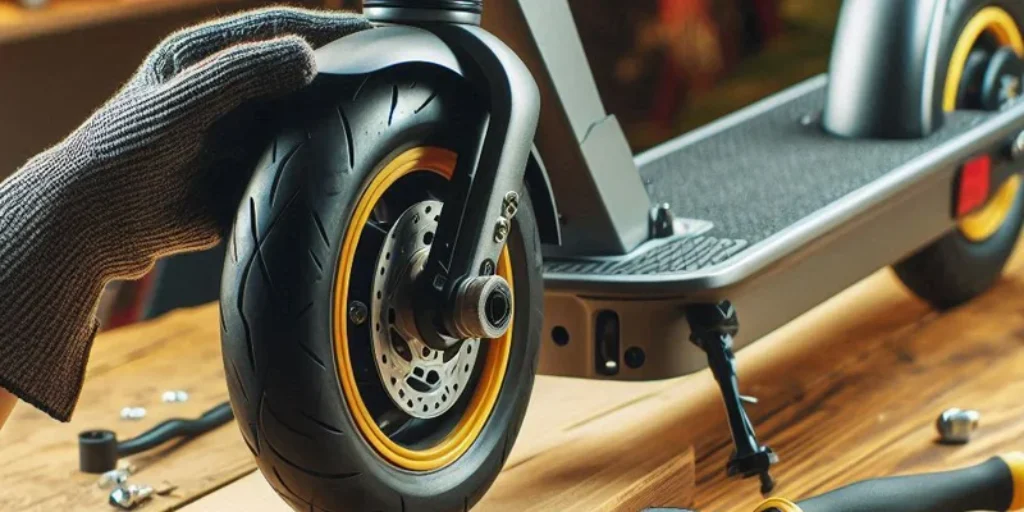
DIY vs. Professional Service
Changing the tires on an electric scooter is definitely not rocket science, but some tires can be more tedious than others. Sometimes getting those new rubbers on can be quite the task, so if that’s not your cup of tea then you can always go to your regular bike shop and have them change them out for a small fee.
If you do decide to go ahead and do it yourself, having the right set of tools is a must. Otherwise you’ll risk damaging your new tires, tubes, vent, and sometimes even the rim.
For step-by-step guidance check out our electric scooter tire changing guide where we walk you through the entire process.
Tools Needed to Change Tires
- Screwdriver
- Wrench
- Tire iron
The tools you need may vary depending on your electric scooter model and if its a motor vs a non-motor tire.
Choosing the right set of tires for your electric scooter
After a quite lengthy, but necessary read we’ve come down to our most frequently asked question about electric scooter tires.
Which type of tire should I choose?
Now why did I bury this question at the end of the article. Simple answer is, without understanding all the different aspects to tires, their benefits, drawbacks, and various models. You wouldn’t know that you’re making the right choice. Sure, I’ve kind of hinted at the best tire for the casual everyday rider, but this guide goes far beyond just the regular commuter, it was built as a guide for both novice and advanced riders.
By now you know there are a lot of aspects to consider when picking the right set of tires for your electric scooter. In the end you have to be the one to make the final choice depending on where you will ride.
For most users it is going to be pneumatic tubeless tires with some type of self-sealing coating inside. These tires are the most versatile tires you can get for everyday riding. They’ll give you good grip no matter if the surface is dry or wet, best shock absorption, and they give you great handling. There is a reason this type of tire has become the industry standard and are found on most of the models on our best rated lists.
If you’re just using your scooter for fast phased fun and never ride on anything but dry surfaces you can opt for pneumatic slick tires.
Personally I never pick solid/honeycomb tires over pneumatic. I have a few models with solid tires and they work great and I do see the benefit of not having to worry about getting a flat. But after changing 100+ tires I feel like I can do it in 5 pitch black darkness within 5 minutes. That said, for someone without the ability to DIY the process of changing tires, solid tires can truly be a bliss.
Off-road tires are not something that the average scooter rider who uses his ride to commute from A to B will use. It is for those with performance models who purposefully seek out dirt tracks to ride for the adrenaline rush.
For winter riding you can get by with a set of normal pneumatic tires for your occasional commute. But if you’re in an area that suffers from heavy snowfall and icy roads, you will definitely feel much more at ease with a set of studded winter tires for your ride.
Conclusion
You’ve reached the end of this long electric scooter tire guide, thank you and great job!
At this point you’ve gotten to know the ins and outs on everything from tire pattern differences, the various materials used, how to apply them for maximum benefit, and how to choose the right set of tires for your ride.
You can now call yourself an electric scooter tire aficionado, equipped with the knowledge to find the right tires for both you and your rider friends, but more importantly you know how to tackle tire issues along the way.
Now all you need to do is get out there and burn some of that rubber you now know everything there is to know about!




